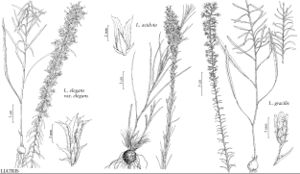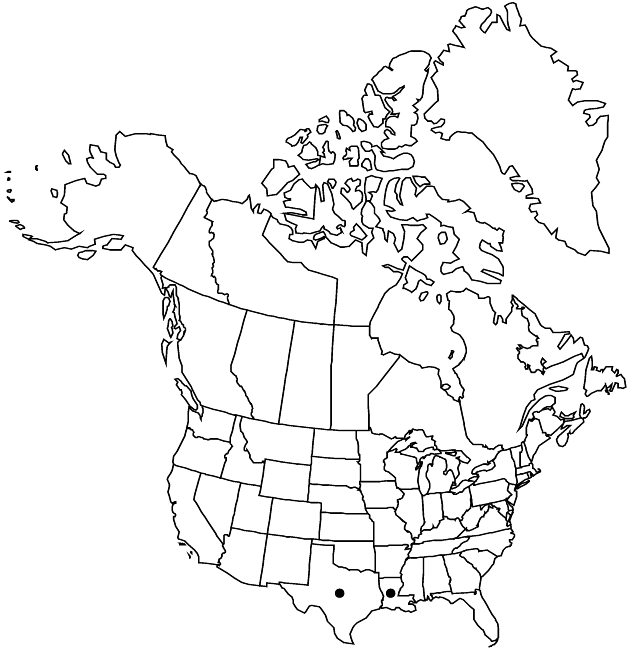Difference between revisions of "Liatris acidota"
Boston J. Nat. Hist. 5: 218. 1845.
FNA>Volume Importer |
imported>Volume Importer |
||
| (5 intermediate revisions by 2 users not shown) | |||
| Line 8: | Line 8: | ||
}} | }} | ||
|common_names=Gulf Coast or sharp gayfeather | |common_names=Gulf Coast or sharp gayfeather | ||
| + | |special_status={{Treatment/ID/Special_status | ||
| + | |code=F | ||
| + | |label=Illustrated | ||
| + | }}{{Treatment/ID/Special_status | ||
| + | |code=E | ||
| + | |label=Endemic | ||
| + | }} | ||
|basionyms= | |basionyms= | ||
|synonyms={{Treatment/ID/Synonym | |synonyms={{Treatment/ID/Synonym | ||
|name=Lacinaria acidota | |name=Lacinaria acidota | ||
|authority=(Engelmann & A. Gray) Kuntze | |authority=(Engelmann & A. Gray) Kuntze | ||
| + | |rank=species | ||
}} {{Treatment/ID/Synonym | }} {{Treatment/ID/Synonym | ||
|name=Liatris acidota var. vernalis | |name=Liatris acidota var. vernalis | ||
|authority=Engelmann & A. Gray | |authority=Engelmann & A. Gray | ||
| + | |rank=variety | ||
}} | }} | ||
|hierarchy=Asteraceae;Asteraceae tribe Eupatorieae;Liatris;Liatris acidota | |hierarchy=Asteraceae;Asteraceae tribe Eupatorieae;Liatris;Liatris acidota | ||
| Line 38: | Line 47: | ||
-->{{#Taxon: | -->{{#Taxon: | ||
name=Liatris acidota | name=Liatris acidota | ||
| − | |||
|authority=Engelmann & A. Gray | |authority=Engelmann & A. Gray | ||
|rank=species | |rank=species | ||
| Line 52: | Line 60: | ||
|publication title=Boston J. Nat. Hist. | |publication title=Boston J. Nat. Hist. | ||
|publication year=1845 | |publication year=1845 | ||
| − | |special status= | + | |special status=Illustrated;Endemic |
| − | |source xml=https:// | + | |source xml=https://bitbucket.org/aafc-mbb/fna-data-curation/src/2e0870ddd59836b60bcf96646a41e87ea5a5943a/coarse_grained_fna_xml/V19-20-21/V21_1332.xml |
|tribe=Asteraceae tribe Eupatorieae | |tribe=Asteraceae tribe Eupatorieae | ||
|genus=Liatris | |genus=Liatris | ||
Latest revision as of 20:09, 5 November 2020
Plants 20–90(–130) cm. Corms usually globose to subglobose, sometimes ovoid to elongate. Stems glabrous. Leaves: basal and proximal cauline 3–5-nerved, linear to linear-oblanceolate, 100–400 × 1–3(–5) mm, gradually reduced distally or abruptly on distal 1/2 of stems, essentially glabrous (bases of basal usually fibrous-persistent). Heads in dense, spiciform arrays. Peduncles 0. Involucres cylindro-turbinate, 6–7(–10) × ca. 3 mm. Phyllaries in 3–4 series, (often purple) oblong-oblanceolate to oblong-lanceolate, unequal, essentially glabrous, margins with hyaline borders, ciliolate, apices (erect or ± appressed) acuminate to acute. Florets (2–)3–4(–5); corolla tubes glabrous inside. Cypselae 4–4.5 mm; pappi: lengths ± equaling corollas, bristles barbellate to subplumose. 2n = 20.
Phenology: Flowering (Jun–)Jul–Oct(–Nov).
Habitat: Coastal prairies, prairie remnants, wet pine flats, savannas, oak-pine, ditches, roadsides, railroads, sand, sandy and silty loams, clays
Elevation: 0–30 m
Discussion
Selected References
None.

